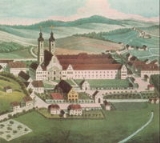
Zwiefalten
Encyclopedia
Zwiefalten is a municipality in the district of Reutlingen
, located halfway between Stuttgart
and Lake Constance
. The former Zwiefalten Abbey
dominates the town. The former monastery is considered one of the finest examples of late Baroque
art.
 Founded at the confluence of two rivers, Zwivaltum was mentioned for the first time in a document by King Ludwig IV
Founded at the confluence of two rivers, Zwivaltum was mentioned for the first time in a document by King Ludwig IV
dated 15 June 904, but the town's claim to fame is its former Benedictine
monastery, the Zwiefalten Abbey
, which was founded in 1089 by monks from Hirsau
. Counts Luitold von Achalm and Kuno von Wülflingen gave extensive donations the monastery. There was also at one time a convent on the spot, but by the 14th century it was no longer there. Until the 15th century, the monastery was influential, but in 1525 the German Peasants' War
resulted in the monastery being plundered.
In 1750 the abbey was granted the status of Reichsabtei, which meant that it had the status of an independent power subject only to the Imperial Crown
and was free of the rule of Württemberg
. By 1802, however, the monastery was dissolved as part of the German mediatization
. Today it is part of the psychiatric hospital.
Reutlingen
Reutlingen is a city in Baden-Württemberg, Germany. It is the capital of the eponymous district of Reutlingen. As of April 2008, it has a population of 109,828....
, located halfway between Stuttgart
Stuttgart
Stuttgart is the capital of the state of Baden-Württemberg in southern Germany. The sixth-largest city in Germany, Stuttgart has a population of 600,038 while the metropolitan area has a population of 5.3 million ....
and Lake Constance
Lake Constance
Lake Constance is a lake on the Rhine at the northern foot of the Alps, and consists of three bodies of water: the Obersee , the Untersee , and a connecting stretch of the Rhine, called the Seerhein.The lake is situated in Germany, Switzerland and Austria near the Alps...
. The former Zwiefalten Abbey
Zwiefalten Abbey
- References :...
dominates the town. The former monastery is considered one of the finest examples of late Baroque
Baroque
The Baroque is a period and the style that used exaggerated motion and clear, easily interpreted detail to produce drama, tension, exuberance, and grandeur in sculpture, painting, literature, dance, and music...
art.
History

Louis the Child
Louis the Child , sometimes called Louis IV or Louis III, was the last Carolingian ruler of East Francia....
dated 15 June 904, but the town's claim to fame is its former Benedictine
Benedictine
Benedictine refers to the spirituality and consecrated life in accordance with the Rule of St Benedict, written by Benedict of Nursia in the sixth century for the cenobitic communities he founded in central Italy. The most notable of these is Monte Cassino, the first monastery founded by Benedict...
monastery, the Zwiefalten Abbey
Zwiefalten Abbey
- References :...
, which was founded in 1089 by monks from Hirsau
Hirsau
Hirsau is a district of the town of Calw in the German state of Baden-Württemberg, located in the south-west portion of the country, about two miles north of Calw and about twenty four miles west of Stuttgart.-Town:...
. Counts Luitold von Achalm and Kuno von Wülflingen gave extensive donations the monastery. There was also at one time a convent on the spot, but by the 14th century it was no longer there. Until the 15th century, the monastery was influential, but in 1525 the German Peasants' War
German Peasants' War
The German Peasants' War or Great Peasants' Revolt was a widespread popular revolt in the German-speaking areas of Central Europe, 1524–1526. At its height in the spring and summer of 1525, the conflict involved an estimated 300,000 peasants: contemporary estimates put the dead at 100,000...
resulted in the monastery being plundered.
In 1750 the abbey was granted the status of Reichsabtei, which meant that it had the status of an independent power subject only to the Imperial Crown
Imperial crown
An Imperial Crown is a crown used for the coronation of emperors.- Imperial Crowns with Mitre :-Legal usage:Throughout the Commonwealth Realms, The Crown is an abstract concept which represents the legal authority for the existence of any government...
and was free of the rule of Württemberg
Württemberg
Württemberg , formerly known as Wirtemberg or Wurtemberg, is an area and a former state in southwestern Germany, including parts of the regions Swabia and Franconia....
. By 1802, however, the monastery was dissolved as part of the German mediatization
German Mediatisation
The German Mediatisation was the series of mediatisations and secularisations that occurred in Germany between 1795 and 1814, during the latter part of the era of the French Revolution and then the Napoleonic Era....
. Today it is part of the psychiatric hospital.

